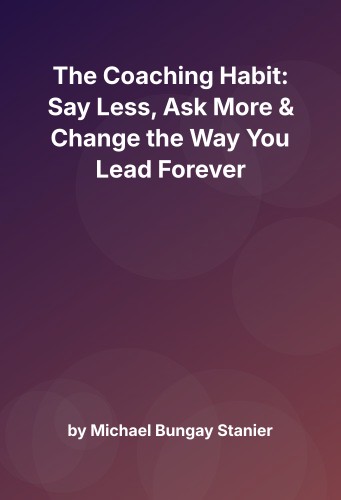The Coaching Habit: Say Less, Ask More & Change the Way You Lead Forever
By Michael Bungay Stanier
Introduction
In The Coaching Habit, Michael Bungay Stanier argues that great leadership is less about giving advice and more about asking better questions. Drawing on insights from behavioral science, psychology, and real-world leadership, he outlines a practical framework for building a daily coaching habit — one that helps others grow while saving leaders time.
His mantra: be lazy, be curious, be often. Coaching isn’t about fixing people — it’s about helping them find their own clarity and courage.
Why Build a Coaching Habit?
Stanier explains that most managers fall into the “advice monster” trap — jumping in to offer solutions rather than staying curious. This creates dependency and burnout, while stunting team growth.
The benefits of coaching:
- Empowers others to think for themselves
- Saves time by reducing unnecessary escalation
- Improves engagement and accountability
- Builds trust and deepens relationships
Coaching isn’t an event — it’s a daily leadership style.
The Science of Habit Formation
To build a coaching habit, leaders must:
- Identify a trigger — when do you default to giving advice?
- Define a new behavior — ask a question instead
- Make it easy — choose simple, repeatable actions
- Repeat and reflect — create a loop of feedback
Stanier emphasizes practice over perfection. Start small. Don’t try to be a coach — just start coaching.
The 7 Essential Coaching Questions
Stanier introduces seven key questions that can transform conversations:
1. The Kickstart Question
“What’s on your mind?”
Purpose: Opens the door to meaningful, focused dialogue.
Why it works:
- It’s open-ended and respectful
- It cuts through small talk
- It invites emotional or strategic concerns
This question builds trust and puts the other person in control of the agenda.
2. The AWE Question
“And what else?”
Purpose: Encourages deeper thinking and reveals additional issues.
Why it works:
- The first answer is rarely the only or best answer
- It creates space for insight
- It stops you from rushing to action
Stanier calls this the best coaching question in the world. It’s simple but powerful.
3. The Focus Question
“What’s the real challenge here for you?”
Purpose: Narrows down to the core issue — personal, not just technical.
Why it works:
- Brings clarity
- Centers the conversation on ownership
- Moves from problems to people
It helps avoid abstract debates and zeroes in on what matters most.
4. The Foundation Question
“What do you want?”
Purpose: Surfaces needs and intentions — often unspoken.
Why it works:
- Clarifies motivation
- Diffuses conflict
- Encourages self-reflection
Many people don’t know what they want. Asking helps them (and you) focus and align.
5. The Lazy Question
“How can I help?”
Purpose: Prevents over-functioning and keeps responsibility where it belongs.
Why it works:
- Forces the other person to articulate support needs
- Prevents assumptions
- Creates healthy boundaries
It’s called the Lazy Question because it stops you from taking over.
6. The Strategic Question
“If you’re saying yes to this, what are you saying no to?”
Purpose: Highlights trade-offs and commitment.
Why it works:
- Promotes conscious decision-making
- Reveals opportunity cost
- Encourages focus
This question prevents overcommitment and drives strategic alignment.
7. The Learning Question
“What was most useful for you?”
Purpose: Ends conversations with insight and reinforcement.
Why it works:
- Encourages reflection
- Locks in learning
- Helps you improve your coaching
It’s not just about the conversation — it’s about growing from it.
The Power of Staying Curious
Stanier argues that curiosity is a superpower. Staying curious:
- Builds psychological safety
- Resists micromanagement
- Encourages innovation
- Models humility
The challenge is your own reflex to give advice. Stanier offers mantras like “Tell less, ask more” and “Slow down the rush to action.”
Creating a Coaching Culture
Coaching can scale across a team or organization when:
- Leaders consistently model it
- Coaching is integrated into meetings and feedback loops
- Questions are normalized in conversations
The payoff:
- Greater team autonomy
- More meaningful work
- Stronger culture of learning and accountability
Common Pitfalls and How to Avoid Them
-
Asking too many questions
— Tip: Pick one or two questions per conversation -
Pretending to be curious
— Tip: Be genuinely interested; don’t coach to manipulate -
Giving advice disguised as questions
— Tip: Avoid “Have you thought about…” phrasing -
Not listening
— Tip: Practice silence and wait longer than feels comfortable
Habit Integration Tips
- Write a coaching question on a Post-it note
- Use questions in email, not just live conversations
- Reflect daily: “Did I stay curious today?”
- Reward yourself for listening, not solving
Key Takeaways
- Coaching is a leadership habit, not a job title.
- Great coaching starts with great questions.
- Stay curious longer — advice can wait.
- Practice one question at a time and build from there.
- Focus on helping others find their own clarity, not just quick fixes.
The Coaching Habit is a short, punchy, and immensely practical guide to transforming the way we lead. By replacing advice with curiosity, it empowers leaders to unlock potential, build trust, and make every conversation count.

